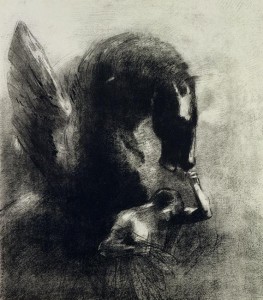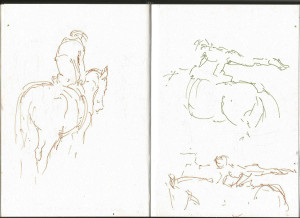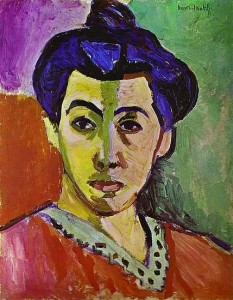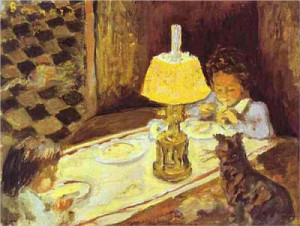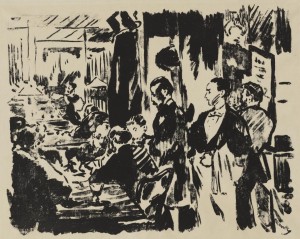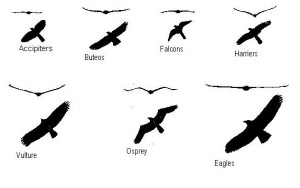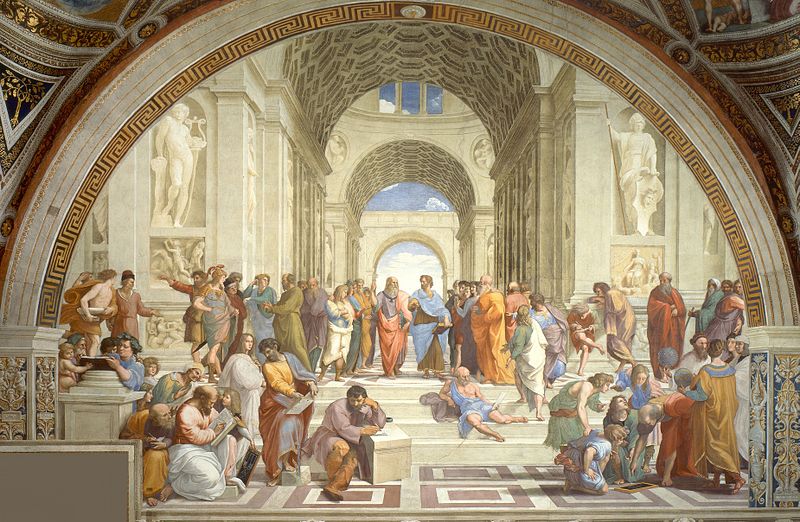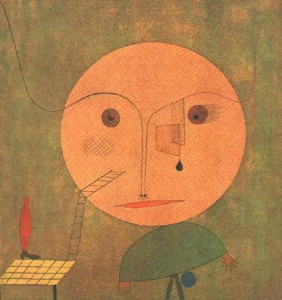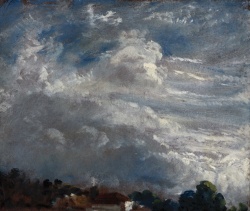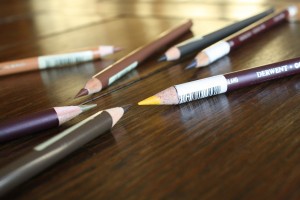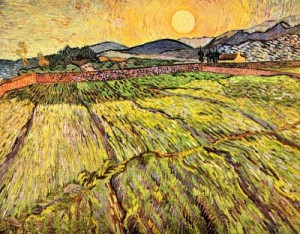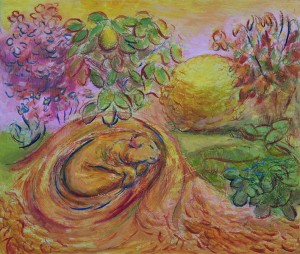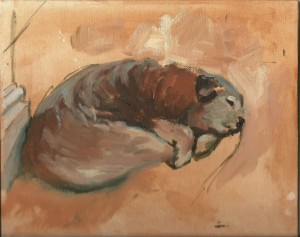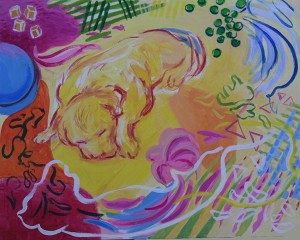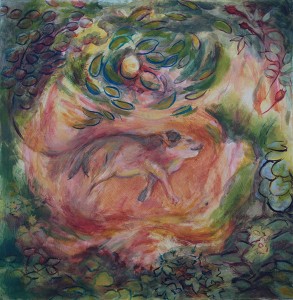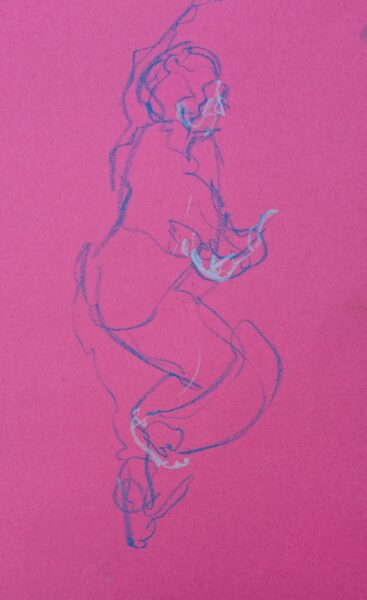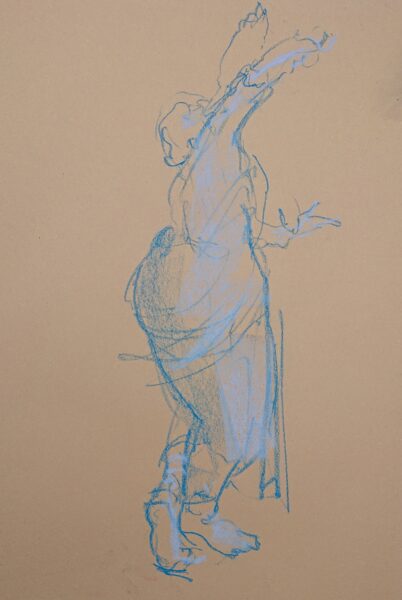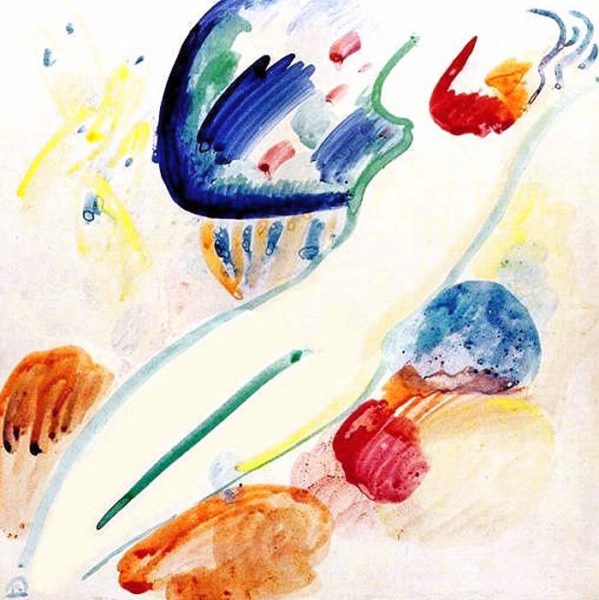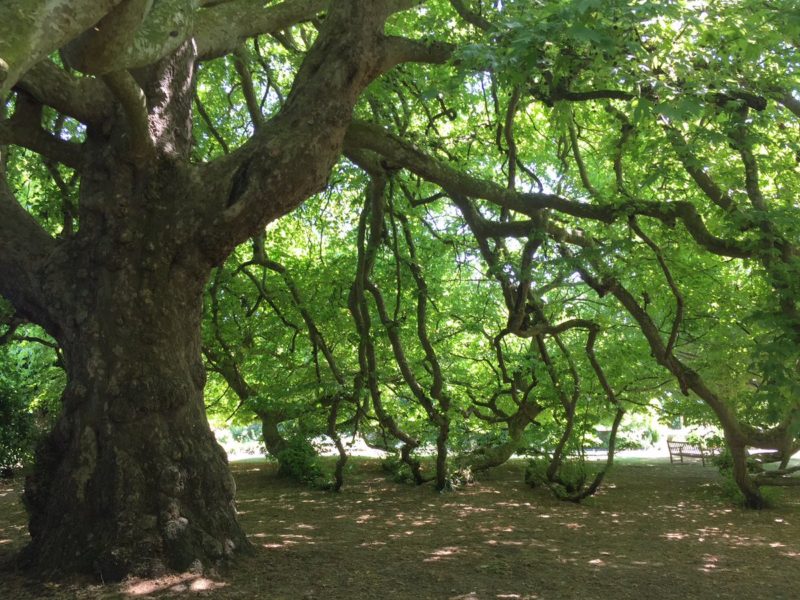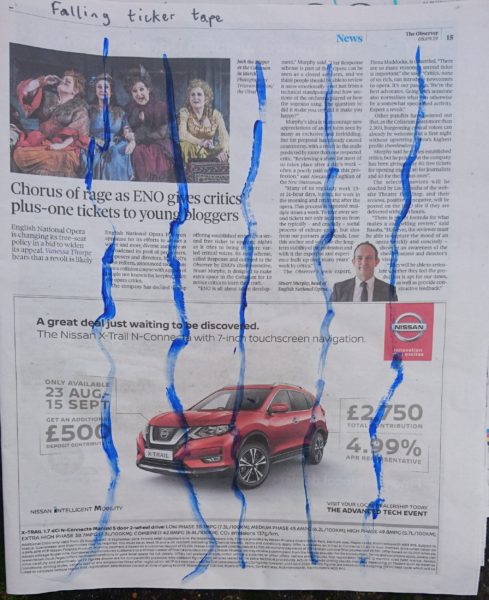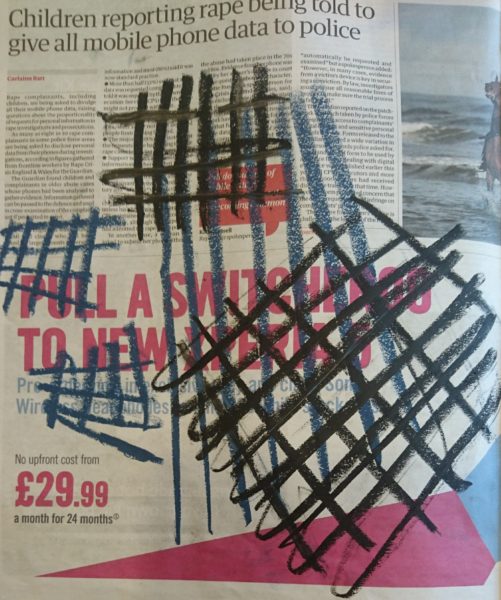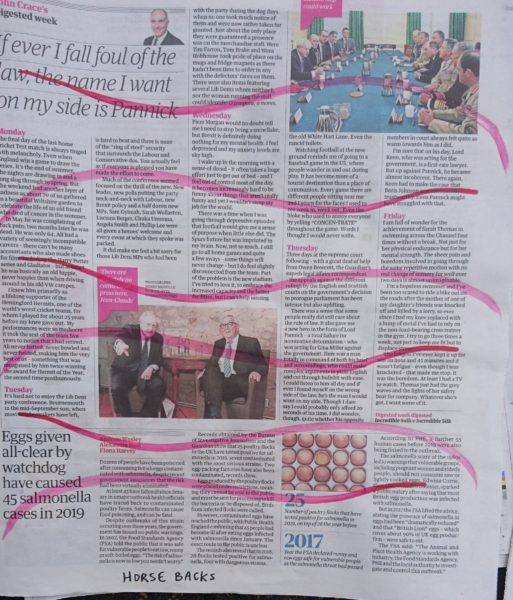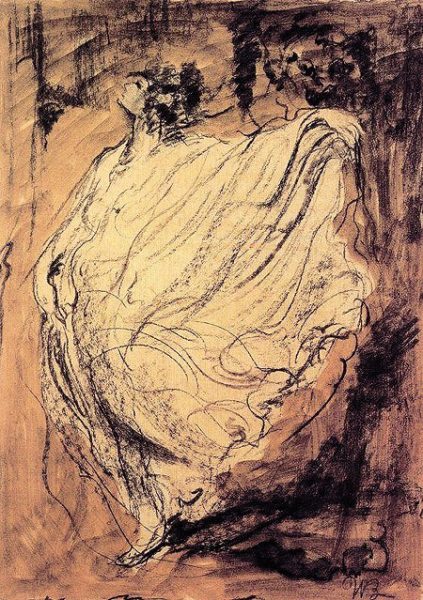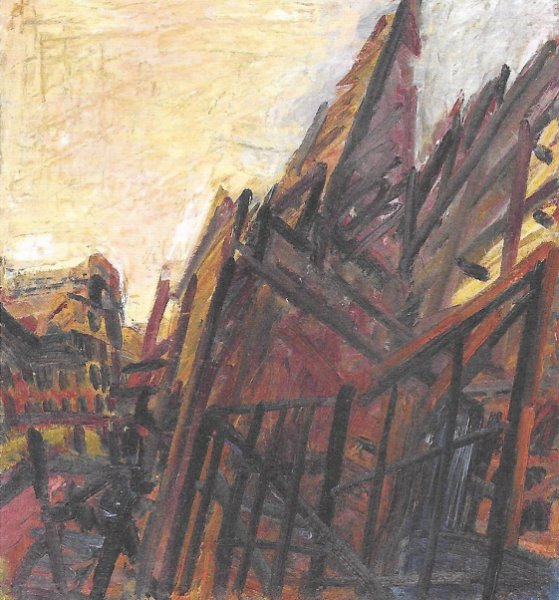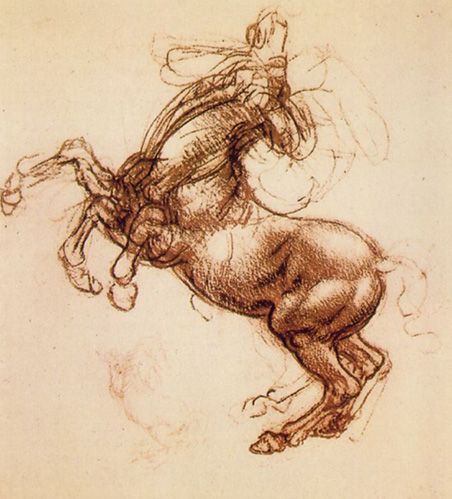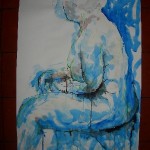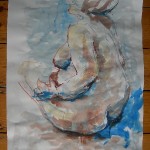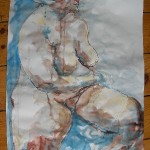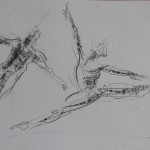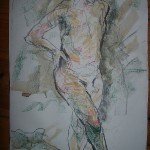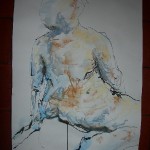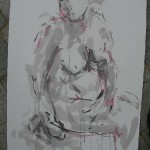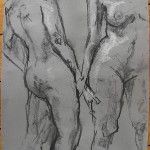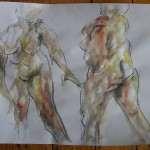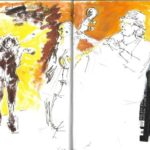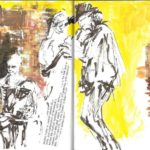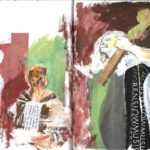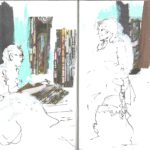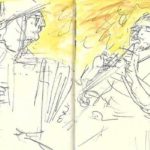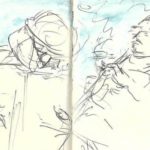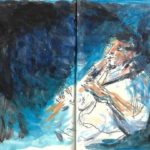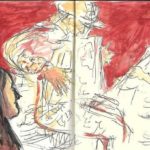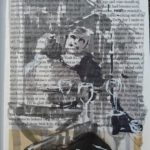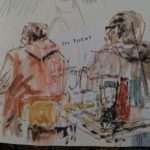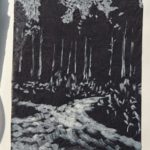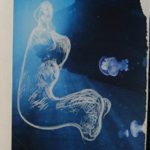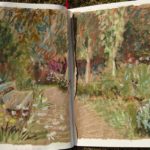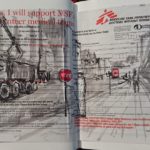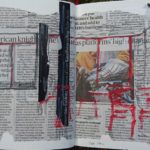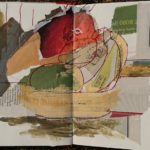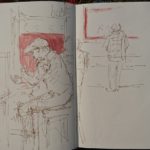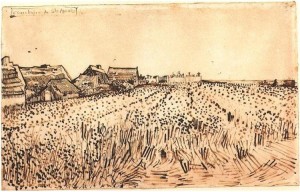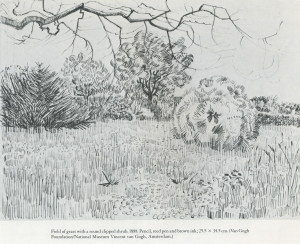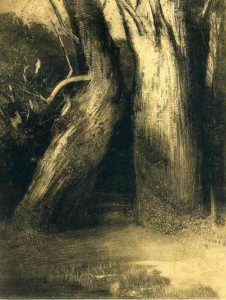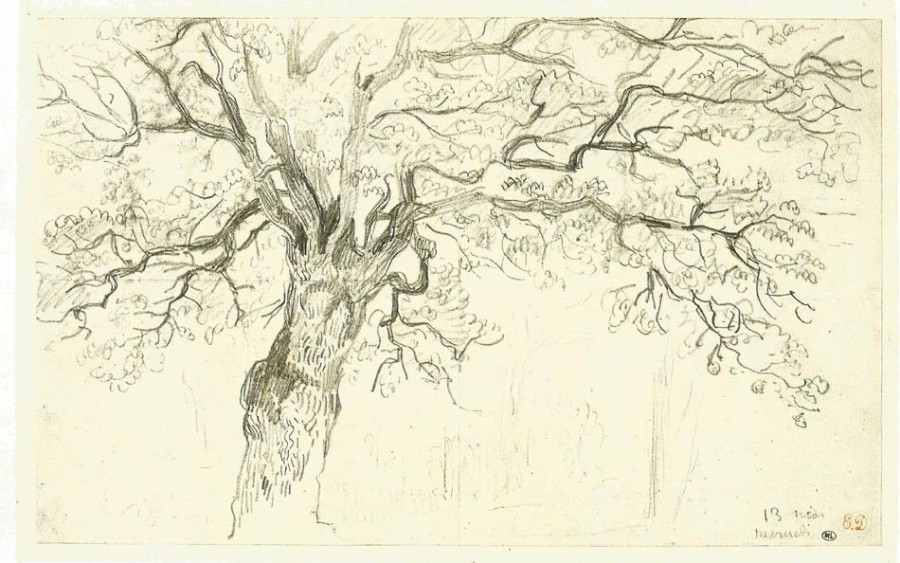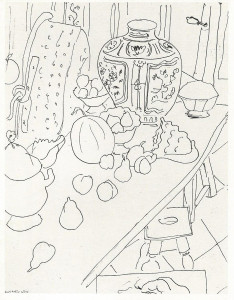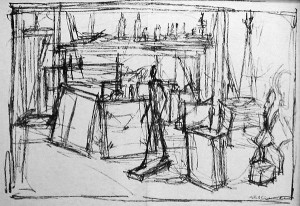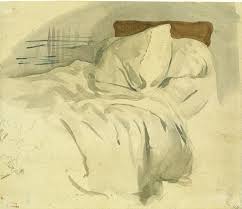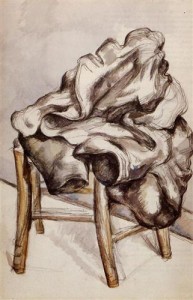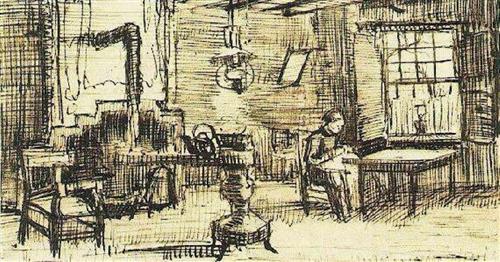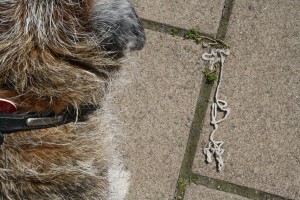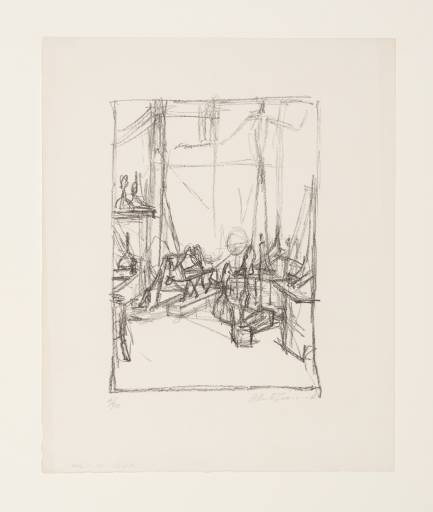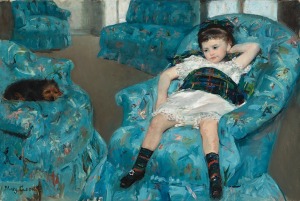Dance and art part 1: Expression and movement
September 18, 2020
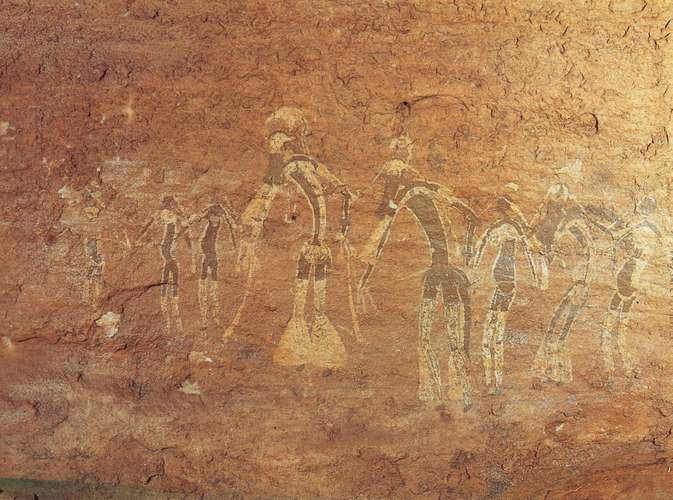
For centuries, the movement, rhythm and beauty of dance has inspired artists. Symbolic and expressive qualities of dance have been conveyed in paint or pigment since prehistoric times.
These two articles look at some of the key ways in which dancers have inspired the creation of two dimensional artwork. In addition, I shall touch on how dancers have in turn been influenced by artists.
Conveying emotional expression
From quiet melancholy to wild abandon, the type of emotion communicated by dancers has long been a source of inspiration to artists.
Even before considering a figure’s facial expression or body posture, emotion can be conveyed on paper or canvas. The range of colours used, the degree of tonal contrast, the technical handling of lines or brush-strokes, and the relationship between the handling of background and figure can all influence the emotion conveyed by the image.
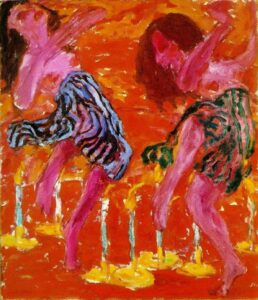
German Expressionist dance paintings of Emil Nolde (1867-1956) suggest at times a wild abandon or a sense of losing control. For example, see his “Candle Dancers”, above.
Though raised as a Protestant, old Germanic legends would have been a key part of Nolde’s upbringing (Jumeau-Lafond, 2008), and indeed some of his dance pictures suggest pagan ritual or demonic possession. Nolde is known to have been influenced by Mary Wigman (Byrne 2012), a pioneering modern German dancer who thought of dance primarily as a means of expressing internal emotional impulses.

The concept of “empathy” was originally closely linked to the way in which people viewed paintings. Robert Vischer, a German aesthetics student, wrote a dissertation in 1873 coining the term “Einfühlung”, literally translating to “feeling into” (Eisenberg 1990, p18). Einfühlung is the projection of people’s ideas, emotions or memories onto objects. The word Einfühlung later got translated into “empathy” in 1909 by the British psychologist Edward Titchener. Robert Vischer was also first to use the term “muscular empathy”: Due to Einfühlung, the viewer of a piece of art unconsciously “moves in and with the forms” (Henderson 2014, p115).
Of course, we also experience muscular empathy when watching dancers perform. The philosopher Theodor Lipps had a particular interest in both empathy and aesthetic enjoyment. Lipps wrote of how he experienced muscular empathy while watching a dance recital: he found himself to be “striving and performing” with the dancers (Lipps 1935, p379).
Representing different types of movement
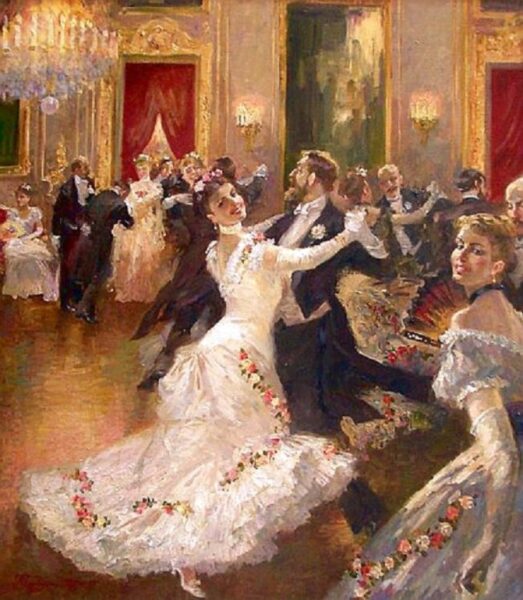
Speed, direction and quality of the dancer’s movement can be suggested by the nature of repeated shapes and lines within an image. Such lines or shapes could be realistically-rendered folds of clothing, or may instead be bold individual brushstrokes or abstracted forms within the figure or background. Straight, geometric lines tend to suggest static held poses or, when repeated, jerky, start-stop movement. On the other hand, sweeping curves within an image are often used to suggest the effect of a more flowing type of movement.
For example, V.Pervunensky’s painting “In The Vortex of the Waltz”, above, contains many elongated, curved sided shapes that come to a point at one corner. Such shapes hint at the elegant lilting, rotating nature of the waltz. You’ll find these shapes forming zones of highlight or shadow within the white dress of the smiling female dancer, and they are echoed by numerous similar shapes throughout the picture: look at gaps between dancers’ limbs, and look at the shapes formed by white gloves crossing black jackets.
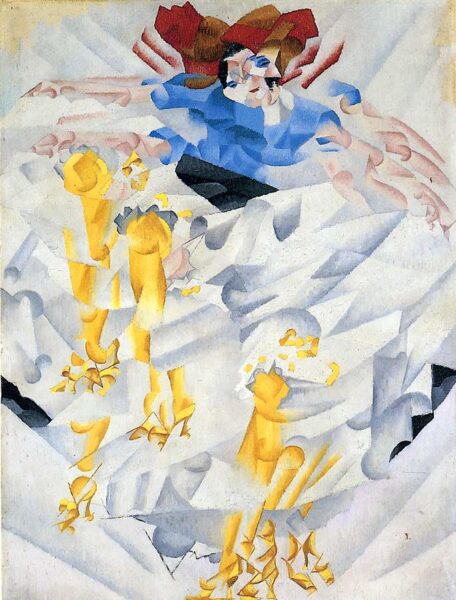
In “Dynamism of a Dancer”, above, we appear to see an arm in one place, and then in another and another. Through an effect similar to stop-motion, such repetition gives the impression of jerky or vibrating movement. Gino Severini was a member of the Futurist group of painters. In addition to celebrating the thrust of technology and the speed of modern life, one of the key visual aims of Futurism was to embody movement on two-dimensional canvas (Kissalgoff 1983).
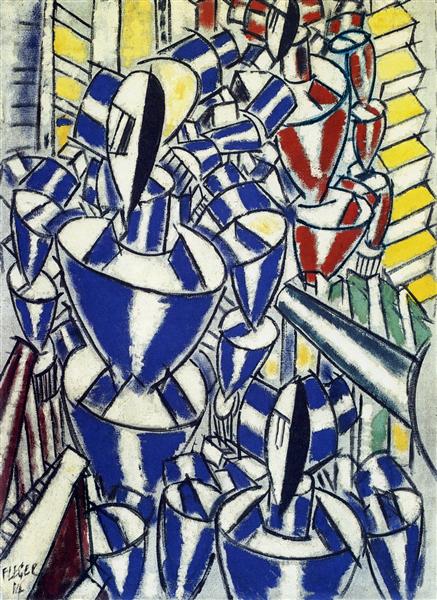
A picture with regular or irregular repetition of similar shapes, tones or colours can suggest a rhythmic movement pattern. It achieves this by sending the viewer’s eye roving around the image making visual connections.
The chosen relationship between similar shapes within an image can hint at the dancer’s type of movement. Shapes may for example appear to tumble or cascade, suggesting that a dancer is doing likewise. Shapes that are distributed equally across the canvas will give a different effect to those that closely abut one another, or to those that are spaced apart at gradually increasing distance. In an image by another Futurist painter, Fernand Leger (1881-1955), “Exit of the Russian Ballet”, above, the dancers are repeated rounded volumes appearing to spin away from us.

The use of repeated shapes, tones and colours to give the effect of rhythm and movement is not by any means limited to modern artists. For example, there is a clear sense of dance rhythm in “The Wedding Dance”, above. Brueghel (c.1525-1569) used strong tonal contrasts to emphasise the repetition of similarly shaped limbs across his canvas. The distribution of patches of each colour across the image also forms an abstract suggestion of rhythm. Look at the overall pattern created by red, or by white, within this wedding dance.

Following the principles of the De Stilj movement, also known as Neoplasticism, Theo van Doesburg (1883-1931) created a picture that is all about dance rhythm. The finished painting, below, uses only horizontal and vertical lines. It represents the rhythmic movement of a single dancer, but has also been compared to the appearance of dance notation (Kissalgoff 1983).
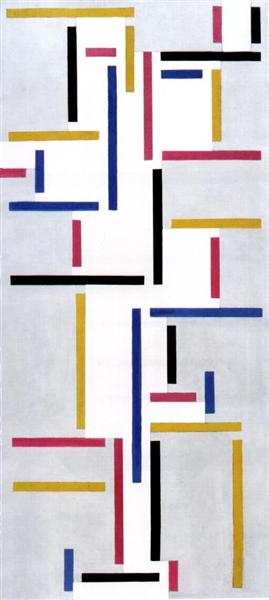
In a bravura display of painting, J.S.Sargent (1856-1925) created a portrait of the famous Flamenco dancer Carmen Dauset Moreno (1868-1910). In this image, below, Sargent not only fulfilled his commission in painting Moreno’s very recognisable face and figure, but he also gave the impression of her having stopped momentarily between dance steps rather than holding a static pose for him in the artist’s studio. The painter used arrays of shapes suggested by the folds of her dress to hint at the various types of movement within Flamenco dancing.
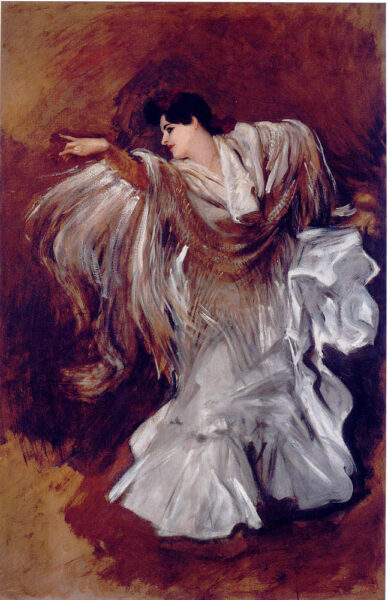
Linking expression and movement in art and dance
American dancer and choreographer Martha Graham (1894-1991) was greatly influenced by a painting by Wassily Kandinsky that she spotted in the window of an art gallery in the early 1920s. “In its most abstract form, it struck her as a brilliant streak of red against a field of blue. Looking at this canvas, she said to herself, ”I will dance like that.”” (Kissalgoff 1983). This experience is said to have inspired Graham’s creation of the 1948 work, “Diversion of Angels”.

Russian painter Wassily Kandinsky (1866-1944) not only influenced dancers, but was himself inspired by dance. He wrote of possible links between dance, colour, and the movement of abstract forms, and developed his own theories of how the colour of a shape affects how it appears to move within an abstract image. In his book, “Concerning the Spiritual in Art”, originally published in 1911, Kandinsky wrote that warm colours appear to advance towards the viewer while cool ones recede. A yellow circle appears to spread out from its centre, while a blue circle seems to move in upon itself like a snail retreating into its shell (Kandinsky 1977, p36-42).
Though primarily a painter, Kandinsky worked closely with dancers and musicians and made a major contribution to thinking about what form a dance of the future might take. One of his central goals was to create a dance that would deal with abstraction (Huxley 2017).
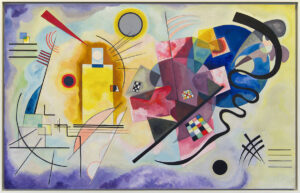
Hungarian dancer and choreographer Rudolf Von Laban (1879-1958) had remarkably similar ideas to Kandinsky regarding the relationships between abstract forms (Dörr 2008, p12).Interested in the space that surrounds the human form, Laban studied architecture at the Ecole des Beaux Arts in Paris and went on to become a pioneering dance theorist. Laban the dancer and Kandinsky the painter both looked closely at how shapes could sweep together, tear apart and change in colour and size, the effect of dark and light, and spatial tensions between shapes and lines.
Some of Kandinsky’s ideas may have been influenced by the teachings of the empathy and aesthetics specialist, Theodore Lipps (see above under “Emotional expression”). Lipps ran a foundational aesthetics course at the University of Munich which was attended by, among others, Brancusi and Kandinsky. (Corbett 2018). Laban the dancer was also based in Munich for a period prior to World War 1, and would at that stage have come across painters from the Blaue Reiter group including Franz Mark and Kandinsky (Maletic 1928). That was certainly a fertile time of collaboration between painters, musicians and choreographers.
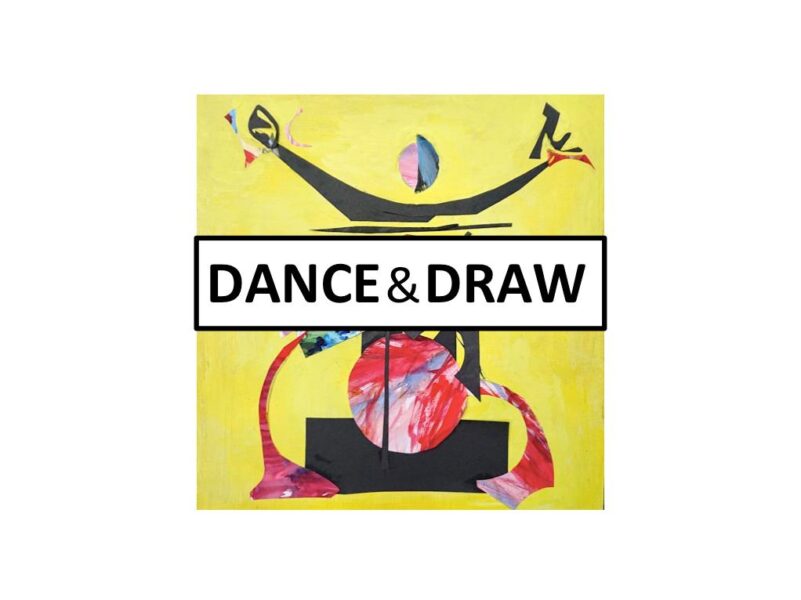
The idea for this blogpost was sparked by the recent creation of “Dance or Draw“. This is an opportunity to dance or to draw/paint dancers. It is run by Mel Simpson, with sessions open to new members and currently held online twice a month.
References
Byrne, B (2012) “Expression through Dance” Aesthetica Magazine, viewed online 10.09.20 at https://aestheticamagazine.com/danser-sa-vie/
Corbett, R. (2016). You must change your life: The story of Rainer Maria Rilke and Auguste Rodin. WW Norton & Company.
Dörr, E (2008) “Rudolf Laban: The Dancer of the Crystal”, Rowman & Littlefield
Eisenberg, Nancy 1990 Empathy and its Development: Cambridge University Press Archive
Henderson, James 2014 “Reconceptualizing Curriculum development” London: Routledge
Huxley, M. (2017). The Dance of the Future: Wassily Kandinsky’s Vision, 1908–1928. Dance Chronicle, 40(3), 259-286.
Jumeau-Lafond, J. 2008 “Emil Nolde 1867-1956” The Art Tribune 11 Nov 2008, viewed online 13.09.2000
Kandinsky, W (1977) “Concerning the Spiritual in Art”. Dover Publications inc.
Kisselgoff, A (1983) viewed online 09.09.20 at https://www.nytimes.com/1983/01/16/arts/dance-view-how-dance-and-other-arts-influence-each-other.html
Lipps, Theodor 1935 “Empathy, Inner Imitation and Sense-Feelings” Translated by Max Schertel and Melvin Rader. In A Modern Book of Esthetics: An Anthology. Edited by Melvin Rader. California: Holt, Rinehart and Winston
Maletic, V. (1928). Body-space-expression: The development of Rudolf Laban’s movement and dance concepts . Approaches to Semiotics Vol. 75. Walter de Gruyter & Co, Berlin.
Comments (2) | Tags: dance, expression, movement | More: Blog
The essence of an object: the role of memory
October 19, 2013
How does memory tie in with the creation of art?
A quick internet search for “memory & art” directs me to websites in which events or people are commemorated in painting, sculpture and other media. Further searching leads me to information on those who use childhood memories to create highly imaginative and unusual work. Drawing from life can also be used to record fleeting memories, and it is interesting how many sketchbook addicts (myself included) claim to use drawing to back up an insufficient memory.
Above: Odille Redon “Pegasus Captive”, 1889, lithograph
What about the artist who sets about painting a still life or portrait? Is memory required for such a process?
To go through the mechanics of drawing a portrait does not require human memory. For example, take a look at the drawing robot. But artists are generally after something more than that. In order to create interesting work that can truly be described as art, perhaps the ability to process memory is essential …
…I’ll let you read on and come to your own conclusions.
“Drawing is remembering”
Once again, I am turning to Henri Matisse for ideas, mainly because he left a wealth of written and spoken information on the subject. Here I am referring to the excellent text of John Elderfield’s “The Drawings of Henri Matisse”.
Elderfield described how the young Matisse would go out with his fellow student Marquet to sketch in the streets of Paris. They attempted to draw silhouettes of people moving in the street. In Matisse’s words: “We were trying…to discipline our line. We were forcing ourselves to discover quickly what was characteristic in a gesture, an attitude.”
Above: Sketches of people and dogs drawn from life, this time by Toulouse-Lautrec. There is plenty of information here about posture and character. In particular, look at the shapes between and around the two dogs.
Attempting to draw moving figures is a real challenge, especially if the subject moves before the artist’s pen touches the paper. Elderfield writes, “sketching in the street…made it evident to Matisse that drawing was indeed not only a matter of observation but of memory: of recording, in fact, not what was seen “out there”…rather, what had been stamped in the mind. The act of drawing was that of remembering.”
Have you tried to draw people or animals who are continuously moving? When I have forced myself to draw, for example, equestrian vaulters on a cantering horse, I have struggled to come up with a meaningful image. To produce a drawing that is representative of the moving subject is a mental challenge that involves looking and thinking and a keen short-term memory for the essentials. A prior knowledge of the subject and a longer term memory is of course also helpful here.
Above: Some of my sketchbook attempts to capture poses of equestrian vaulters in action.
“My painting is finished when I rejoin the first emotion that sparked it”¹
So said Matisse. And he also gave great importance to remembering the initial spark of emotion that came at the beginning of the painting. Matisse wrote of looking at the subject (e.g. still life or figure) with an open mind and really observing the subject in a concentrated way. “..The subject is experienced, and drawing is the record of that experience, of the unconscious sensations which sprang from the model.”
Above: Henri Matisse “The Green Stripe”, a portrait in oils of his wife, Amélie Noellie Matisse-Parayre, 1905
There is no point in trying to record the ever-changing present while it is taking place, as life goes on and the subject alters, as does the artist’s response to it. Even when drawing a “static” professional model or a pot plant, there are tiny changes over time. Consider changes in the lighting, the mood, and your (the artist’s) response to the subject.
Matisse believed that, instead, the artist must preserve the memory of the first concentrated observation. Elderfield interpreted Matisses’s outlook as follows: “To remember the first unconscious sensations which sprang from the model is to make a drawing”.
Rediscovering reality
In creating a drawing or painting, the artist may work up to a point at which their image starts to coincide with a recent or much more distant memory. They may think back to the initial “spark” of emotion of that day’s work. Alternatively, something about the image may start to resemble some other memory, recent or distant, within the artist’s mind.
Above: Pierre Bonnard “The Lunch of the Little Ones”, 1897
Proust wrote of “the grandeur of real art” involving the rediscovering of a reality that is “a certain relationship between sensations and memories which surround us at the same time”.
Is this fanciful?
No…. In going about our daily business (making breakfast, walking through the street, etc.) we are surrounded by all kinds of sensations and memories, both conscious and subconscious. As we walk through the street, we are not only aware of the pavement ahead , but also of surrounding buildings and people. Even if we are paying no direct attention to architecture, we are still certainly aware of being surrounded by, say, looming skyscrapers as opposed to neat residential houses. There may also be noise, perhaps traffic, birdsong or chattering people.
In addition, our head and eyes are continuously moving as we walk. Unlike a smoothly-gliding video tracking system, our eyes glance about all over the place, catching a glimpse of this here and of that there. We need some kind of very short-term memory system just to make sense of this. There might be a glimpse of the kerb, a flash of a car going by, a recognised face in the crowd, the brief sight of a cake in a shop window and also of our own feet as we step on the pavement. Much of this is mundane and quickly-forgotten. The occasional image (a girl in the street, a hat in a shop window) or combination of images may trigger a new emotion or distant memory. That is part of the human experience.
Above: Edouard Manet “At the café”, 1874, gillotage on beige wove paper. This complex image of a crowded room is simplified into rhythmic lines and strong shapes. Angles of heads are essential here, as are shapes of spaces between people. With a minimum of detail, Manet shares with us (across the centuries) the atmosphere of this noisy café.
Painting from memory
Henri Matisse said that he painted “from memory”. Numerous drawings made prior to a painting were created, not as first draughts, but to gain a deeper understanding of his subject. He wanted to know objects thoroughly before attempting to paint them: “Deep within himself…[the artist] must have a real memory of the object and of the reactions it produces in his mind”.
Matisse certainly did not transpose his drawings to a canvas in order to make a painting. He claimed not to be satisfied with a mere enlargement. Whether he used his drawings for close reference, or just put them to one side and truly painted “from memory”, I am not sure.
How can we use these ideas in practice?
The techniques and craft of painting can be learned, but what about the artistic, intuitive aspects? Is it possible, for example, to learn to improve our awareness and application of memory in drawing and painting?
Yes, certainly, with some careful thought and application, though it is a gradual process.
In my next article, I shall share practical suggestions on how to go about this using a series of mind games and simple drawing exercises.
1) Quoted by Pierre Schneider within “The Bonheur de vivre: A Theme and its Variations” lecture at MOMA, New York, 30 Mar 1976
| Tags: essence of an object, Matisse, memory, sketchbook | More: Blog
The essence of an object (2): The thing-ness of a thing
September 16, 2013
 Above: Henri Matisse “Branch of a Judas Tree”, 1942, charcoal on paper, 25.2×39.4cm
Above: Henri Matisse “Branch of a Judas Tree”, 1942, charcoal on paper, 25.2×39.4cm
Writing in 1947 about some fig leaves that he was drawing, Matisse described how he was searching for the qualities that made them “almost unmistakably fig leaves”. He did not want to record exact copies of particular leaves, complete with their idiosyncratic folds and imperfections. Instead, Matisse worked to find the “common quality” that united things despite their visible differences. He wrote of searching for an “inherent truth” about the fig leaves.
As we can see from Matisse’s drawing of another plant, the Judas Tree, above, the general shapes and spacing of the leaves, and the shapes of the gaps between them, give the plant an immediate identity.
As humans, we find it easy to identify objects by their general shape (either the shape of an outline, or by the shapes of dark or light tones):
Above: Various types of birds of prey, quickly identifiable by their general shape
Thing-ness, identity and emotion
Though each differs from the next, all of the above bird silhouettes have a recognizable bird-identity. What is it that makes all of these shapes so recognisably bird-like; what gives them all a quality of “bird-ness”? It is the general shape, and the relative proportions of head, out-stretched wings and tail.
If we so wished, we could create a new imaginary bird silhouette that was still recognisably bird-like, without having been copied from any existing bird species.
When playing around with new bird-like shapes, when do our drawings lose the quality of bird-ness, i.e. when can they no longer be “read” or “understood” as birds? Feel free to experiment with this yourself.
The quality of “thing-ness” can produce a strong emotional response. Imagine showing a drawing of a spider to someone who is terrified of spiders. You would expect them to be upset, whichever type of spider you had drawn. Now, what if the spider drawing was distorted. Would the arachnophobic person still be repulsed by your image? How much would you need to distort the image to make it acceptable to an arachnophobe? Would it be sufficient simply to make the legs of the spider extremely short, or to make its body very long, or to give it a different number of legs? To someone who has a great terror of spiders, you may need to distort the image considerably before it loses its quality of “spider-ness” for them.
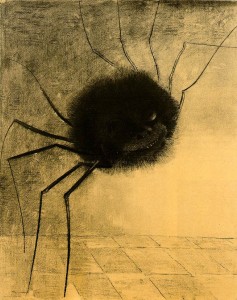
Above: Odille Redon “The Smiling Spider”, 1891
The Platonic Ideal
This discussion of things and identity brings me to Plato’s ideas. He talked of the Ideal of a given form, which was the embodiment of all the particular examples of that form.
In order to see or imagine such an ideal form, one needs a reasoning mind. Here is an extract from “The Journal of Speculative Philosophy” Volume 4 , by William Torrey Harris, 1870:
“When Plato spoke of the goblet-ness and table-ness, Diogenes the cynic said, “I see indeed the table and the goblet, but not the table-ness nor the goblet-ness”.
“Right” answered Plato; “For though you have eyes which serve to see the table and the goblet, yet the wherewith to see the table-ness and goblet-ness, i.e. Reason, you have not”.”
Above: Raphael “School of Athens” , fresco, Diogenes is lying on the steps, and Plato is standing in front of the central open archway, wearing red and purple robes.
The perfect Platonic Ideal Form might be something that no human has ever come across. For example,
“No one has ever seen a perfect circle, nor a perfectly straight line, yet everyone knows what a circle and a straight line are”. (based on Plato’s “Cratylus”, paragraph 389)
Above: Paul Klee “Error on Green”, 1930
How might the Platonic Ideal be applied to drawing and painting?
Artists have long intended to create images representing the perfect example of an object, being or landscape. They might go out with sketching tools in order to record the many random quirks of nature, but the final picture tends to be a long-considered ideal image. The artist collates all his or her previous observations in order to make a final enduring image.
When I talk here about the “ideal” image, I do not necessarily mean one that is the most beautiful or pleasing. It may rather be the image that best sums up the appearance of a stormy sky, or the character of a complicated individual.
John Constable gave lectures on landscape painting at the Royal Institute in 1836, and this is what he had to say about condensing information into an ideal image:
“…the whole beauty and grandeur of Art consists…in being able to get above all singular forms, local customs, particularities of every kind…
[the painter] makes out an abstract idea of their forms more perfect than any one original”
Above: John Constable “Cloud study, horizon of trees”, oil on board, 1821. Though he was a great observer of landscape detail and weather change, Constable strove to create a perfect final image that summarised and surpassed all of this.
How do we recognise objects?
The human brain performs an amazing feat when it identifies an object. We take the complexity of this task for granted. Take, for example, our ability to recognise a pencil as a pencil, at first glance and without thinking about it. The pencil could be under any type of lighting conditions, and could be in any position. It could be any type of pencil. The possibilities are endless. In addition to this, our heads tend to be moving all the time as we go about our daily lives, so our eyes’ view of the pencil would be moving and fleeting, rather than a fixed frame like a photographic image.
In his fascinating paper, “Art and The Brain”, published in Daedalus in 1998, the neurobiologist Semir Zeki proposed that we have a kind of Platonic Ideal of each object in our mind “such that a single view of an object makes it possible for the brain to categorize that object”. He suggests that this Ideal image would be developed from the brain’s stored memory record of all the views of all the objects that it has seen. Considering the Platonic system, Zeki writes that “there can be no Ideals without the brain”. So the brain is of great importance here.
Which part of the brain is most involved in object recognition? According to Zeki, it is a region known as the inferior convolution of the temporal lobes that somehow processes stored memory records of all previously-seen objects.
The purpose of art and the “Ideal” or quintessential image
We look at real-life objects in many situations and remember numerous images of them. In addition, we can add to our brain’s stored memory record by looking at pictures. Art helps curious people to learn about the world, and pictures that portray a quintessential, or Ideal image have a special function here.
According to Zeki (Inner Vision 50-51), art, like the brain, seeks:
“to represent the constant, lasting, essential and
enduring features of objects, surfaces, faces, situations, and so on, and thus
allow us to acquire knowledge, not only about the particular object, or face,
or condition represented on the canvas but to generalise from that to many
other objects and thus acquire knowledge about a wide category of objects or faces”.
The art of simplification
 Above: Henri Matisse “Young woman sleeping in a Rumanian blouse”, 1939, charcoal on paper, 37x47cm
Above: Henri Matisse “Young woman sleeping in a Rumanian blouse”, 1939, charcoal on paper, 37x47cm
Referring to the process of drawing a clothed figure, Matisse said:
“The fabric of the blouse has a unique character. I want to express, at one and the same time, what is typical and what is individual, a quintessence of all I see and feel before a subject.”
How should artists go about achieving this “quintessence”?
For many, simplification is key.
For example, many of Eugene Delacroix’s journal entries discuss the importance of suppressing detail. Here is an extract from 23 April 1854 in which he discusses the way in which an artist keeps the first pure expression throughout the execution of his work:
“can a mediocre artist, wholly occupied with questions of technique, ever achieve this result by means of a highly skilful handling of details which obscure the idea instead of bringing it to light.”
Matisse himself is known to have worked over many of his drawings repeatedly, not adding and over-working the image, but erasing and replacing marks until he was satisfied that he had placed each curve and line optimally.
Here Matisse describes his simplification process when drawing lace:
“You see here a whole series of drawings I did after a single detail: the lace collar around the young woman’s neck. The first ones are meticulously rendered, each network, almost each thread, then I simplified more and more; in this last one, where I so to speak know the lace off by heart, I use only a few rapid strokes to make it look like an ornament, an arabesque without losing its character of being lace and this particular lace. And at the same time it still is a Matisse, isn’t it?
I like Matisse’s emphasis on drawing studies until he “knows the lace off by heart”, i.e. has a deep understanding of it. In fact, once the stage of knowing the object off “by heart” is reached, the artist is capable of making a simple drawing from memory. In conveying the essence of an object, memory is of the utmost importance. But I shall come back to this point in a future article.
| Tags: blog, Delacroix, essence, essence of an object, Ideal, Matisse, Plato, Zeki | More: Blog
Memory pictures in progress
November 19, 2012
Exploring ideas around identity and memory
Above: Vincent Van Gogh “Landscape with ploughed fields”, 1889, oil on canvas
Starting points for art: Working from life vs. an emotional starting point
I spend much of my time drawing and painting from life. Shapes, colours, tones and volumes interacting with one another in the real world are intriguing and can inspire work that is infused with emotion. For example, think of Van Gogh’s landscapes, such as the one shown above.
A fresh approach for me is to start with an emotion and then to build an image around it. Colours, shapes and symbolic forms can be used within the picture, and reference to living things is used as a tool rather than as a starting point. This way of working requires a “focus” of emotion to enable the artist to reach a meaningful conclusion. It is an extremely personal way to create a picture, and the process of planning the image not only documents the artist’s emotions, but can also help the artist to process and understand what they are thinking.
A personal response to the death of a pet as the starting point for pictures
I am currently working on a series of paintings following on from the death of my old dog, Freddy, but do please read on. While my initial thoughts on the subject were bleak, I am now finding (7 months on) that these pictures automatically fill with warm colours and are optimistic.
None of these are completely finished, glazed or framed, and the final one is still rather at the sketch stage. I have decided to write something about them in this blog, even at this unfinished stage, to share some of the self-questioning behind the images.
The distortion of shape and colour in remembered, emotional images
On trying to make sense of losing the dog in the first few days, the image in my “mind’s eye” no longer placed him in the real world in a logical fashion. Having previously done so many sketches of him lying on the floor, or next to a table, or resting in the garden, I could now no longer think of him and his surroundings as being predictable volumes. My visual understanding of the situation reminded me of Chagall paintings, with figures, trees, land and sky no longer connected in a real, three-dimensional sense but distorted and curled around one another, and with colours relating more to emotion than to the effect of light on the objects.
Above: Marc Chagall “The Concert”, 1957, oil on canvas
Deciding to paint a picture based on the subject of pet loss has forced me to grapple with ideas about identity, death and memory. If we have visual images relating to such subjects, they may be floating, fleeting, distorted and continuously changing. How should one “pin down” these images and paint them within the confines of a traditional rectangular canvas?
Burial, the passage of time and the natural recycling of life
My first thought was to create an image of the dog beneath the garden with plants flourishing above and around him. I had thought of making a series of similar pictures of the same garden and the same body as the seasons changed, perhaps one with roots curling down and shoots coming up, one of an over-lush intensely green summer, a painting with the warm colours of autumn and one under a blanket of snow. I was interested in the thought of a body having a permanent “resting” place, while life went on around it. However, my first attempt, “Freddy is in the garden: Autumn”, made me think and reconsider.
Above: “Freddy is in the Garden: Autumn”, oil over acrylic on prepared board, 30x36cm
The portrayal of an identity after death: A dilemma
Thinking clearly and logically, I knew that the dog was now a lifeless, unfeeling but still perfectly three-dimensional body, and was buried in my garden. Whereas, when he was alive, the answer to the question “where is Freddy?” would of course have been to point at his body, now I am not so sure. Yes, the body is still “Freddy” in one sense, but we could also now think of it as a decomposing, lifeless, “empty” thing, and not “Freddy” at all. In discussing this recently, a friend described a buried body as an “empty vehicle” and, yes, this rings true with me in some way.
So, how should one draw or paint a buried body? My strongest visual memories of him are close to the oil sketches that I had made earlier this year. In the painting, above, I had used the rather endearing image of him curled and resting, as shown below:
Above: Freddy oil sketch from life
This is a typical posture of a relaxed, sleeping dog. It is soothing for us to think of a dead body in a sleeping position. But now I questioned myself: Perhaps the creation of a pleasing image is not a good enough reason for me to paint him curled up? Indeed, he was even unable to lie curled like this in the last few days of his life due to arthritis and spinal pain and, after death, would anyway be crushed under a weight of earth. My curled, resting image harked back to an old memory rather than relating to an actual dead dog. Had I painted a lie?
Had I been too dishonest in showing a sleeping, happily curled dog underground? Another option would be to paint a squashed, rotting body – would that be more honest? If I insisted on painting “what is physically there in that place” then, yes, perhaps I would need to show an actual decomposing body. But what I had really set out to show was not an empty, anonymous, decomposing “vessel” but this particular individual dog, a representation of his identity or of his “Freddiness”. An image of his rotting body would no more show “him” than would a clipping of his fur, or a little collection of his dropped milk teeth, or a vial of his blood taken last year and stored (don’t worry, I don’t have that final one!).
Also, consider this: On the microscopic level, a dead body is gradually absorbed by surrounding micro-organisms and “taken up” by the garden. The plants consequently absorb the released nutrients and grow but of course they do not assume the identity of the dead dog. Insisting on using the body as a representation of identity becomes more problematic the more I consider it.
In my opinion, to suggest the dog’s identity in the picture, an image from life is more helpful. To show this from my own point of view, a representation either purely from my memory, or based on a sketch that I had originally made myself, would be more appropriate than one copied from a photo. As for showing him in a sleeping position, this is interesting in itself and could inspire some discussion. It is almost instinctive to curl a pet up into a sleep-like position before burial. This says more about us as living people than about them as dead animals.
A warm image to encourage people to stop and think
Taken as the final word on the subject, the concept of my painting, “Freddy is in the Garden (1): Autumn”, is perhaps flawed. However. I have concluded that it is worthwhile as part of a series of images.
The curving lines that echo one another are there to represent the cycle of natural decay and regeneration which I certainly do believe in (i.e. the decay of dead bodies allows plants to flourish, and further animals then feed on the plants). The lyrical, curved shapes, the warm colours and the comfortable representation of the dog create a picture that is easy to look at. In painting this, I am not trying to say that death is a great comfort or that an underground grave is a warm and pleasant resting place. The warmth of this picture draws the viewer in and gives them a chance to wonder for themselves about this subject. Rather than making people flinch away, anyone can look at this and think and talk, even young children.
A link between identity and memory
So it seemed that this picture had more to do with memory (mine) and identity (his, as seen by me) than to the physicality of death and burial. After picking up a second-hand copy of a book about Expressionism, I decided to make a “memory picture” of the dog in the house, perhaps suggesting the way in which an old dog seems to become part of the room and how, when gone, they leave a strange and awkward gap. This was based on an oil sketch made earlier in the year from life. Interestingly, I found myself drawn to using plenty of pinks in this image. There is currently a huge cultural push insisting that “pink is for a girl”. That is not why I used pink here. I liked the warmth of the colour, and the way in which I could flood the inside and the outside of the dog (the background floor) with the same pink.
Above: Memory picture (1)
Colour “flooding through” the dog image
This has led on to another “memory picture”. If the inside and outside of the dog can be flooded with the same colour, then how about taking this to another stage and just showing him as an outline? In the painting, below, he has almost become a symbol. I do not believe in ghosts, but it is interesting how they are sometimes portrayed as tranluscent beings within a physical world, perhaps as shadow-less outlines.
Above: Memory picture (2), acrylic on prepared board, 41.5 x 33.5cm
The dog in the above painting was copied from a pen drawing from one of my old sketchbooks. Inspired by Matisse, I felt free to use colours and patterns of my own choice around him. Some of the squiggly lines are copied from lively sketchbook drawings of my children. In the original sketches, these lines represented folds of clothing or bits of arms or legs. Other shapes hint at food treats or toys. I aimed to suggest a dog in a living room surrounded by mess and typical lively family chaos, but also enjoyed adding and overlaying shapes and patterns to balance one another in an abstract sense across this painting.
So, where is Freddy? Another dilemma and a deliberately ambiguous image
For my next picture, I have returned to the thought of a dog who has lived and died and who now has a place within the garden. Rather than attempting to show a static image of dead body, or a ghost, spirit or visible soul, I am aiming to keep this picture very ambiguous. I started the painting in a very “loose” manner, and have deliberately left it unclear as to whether the dog is remembered as alive or dead, resting or dying as seen from above, or perhaps even running as seen from the side. There is also ambiguity as to whether he is represented in a hole in the ground, resting on the surface of the land or, perhaps, hovering.
Above: “Freddy is in the garden (2)”, unfinished, oil over acrylic on prepared board, 32 x 31.5cm
As for representing the garden in the above picture, I have suggested patches of light and shade and, in some places, I am painting plants that really do grow in my garden. Some are painted as seen from above, and others are perhaps viewed from the side. The quince grows in my garden and is used here as a symbol of long-standing plant fertility and for the warmth of its yellow colour.
The aim is to retain enough ambiguity for this painting to read as a memory picture rather than as a three-dimensional attempt at physical accuracy. From looking at the picture, the viewer should have a chance of understanding something of what I was thinking, but should not have enough information to make a three-dimensional sculpture of my image.
Shared ideas
One reason for sharing this small group of pictures is that they offer an interesting talking-point. They could be “read” simply as images of pet death, or these optimistic-looking pictures could open up thought and discussion around more terrible kinds of loss. These paintings have certainly made me question my own beliefs about identity, death and visual memory. If you have further ideas, comments, or differences of opinion, then you are very welcome to discuss by adding to the comments box below.
Comments (1) | Tags: acrylics, blog, death, dogs, Freddy, identity, memory, oil painting, oils | More: Blog, Paintings
Dance and art part 2: Some practical approaches to drawing or painting the dancing figure
December 01, 2020
Drawing or painting a dancer presents us with a special problem. How can we use a still image to represent a moving figure?
There are many possible ways to go about this intriguing challenge. Part 1 of this two-part mini series gave tips on suggesting movement and expression when painting or drawing dancers. Part 2 now goes on to focus on some practical approaches to drawing or painting the dancing figure.
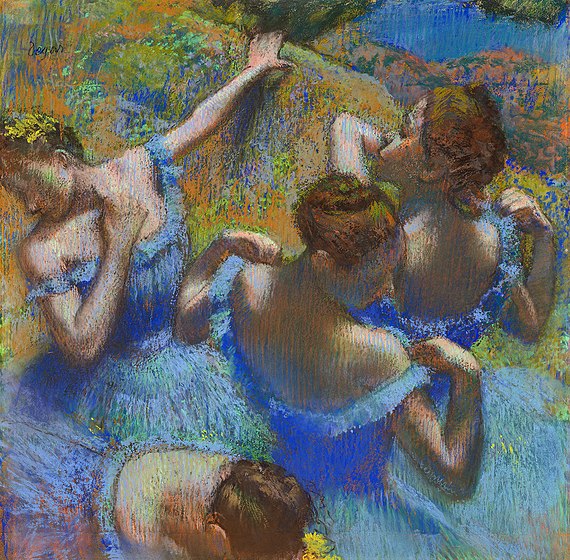
Above: Edgar Degas “Blue Dancers”, 1897, pastel
Approaches to drawing dancers include:
Sketching dancers from life in the theatre or rehearsal room
Drawing from the posed dancer hired to model in costume in the studio
Working in the studio from photos
Working in the studio from video footage
Drawing or painting without a current reference, using a combination of memory and imagined images.
It can be useful to combine at least two of the above methods.
Drawing the moving dancer from life
Sketching someone as they dance is of course extremely challenging: It involves trying to record the present while it is taking place before it can slip into the past. It feels impossible! Why should the artist attempt such a thing?
Drawing from life gives us the opportunity to experience the dance on an emotional level rather than simply recording mechanically. An artist who observes the dancer in real time is in a position to convey the emotional impact of that experience. Resulting images won’t be photorealistic. But perhaps this is not what we are striving for:
“It is the artist who is truthful, while the photograph is mendacious; for, in reality, time never stops cold”
Auguste Rodin
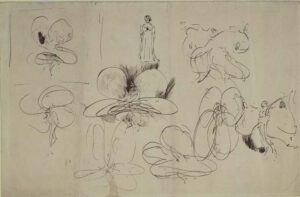
James A.M. Whistler “Louie Fuller dancing”, 1892, pen and black ink
Some practical tips for drawing a moving dancer from life:
Take a little time to observe the dancer(s), to absorb the atmosphere and to listen to the music before starting to draw.
It can help to start by sketching in a few lines to suggest the background. The dancer’s surroundings do not move and can therefore become a helpful reference for you. If outdoors, where is the horizon line? If indoors, lay out a few marks to suggest the floor (e.g. edge of a rug or floorboards), and perhaps mark on the page where the floor meets the edge or corner of the room.
The dancer can be drawn using a rapid almost continuous line, barely lifting the pencil, paintbrush or pastel from the page.
Short sticks of pastel or charcoal could be turned on their side to block in broad directional marks of colour and tone
Do not be too hard on yourself: See if you can capture your immediate visual response to the dancer rather than a “likeness” or totally “realistic” drawing. Some drawings made from the moving figure may look barely human, but they nevertheless capture something of the essence of the dance.
Drawing the posed dancer
Once his studio was well-established, Auguste Rodin (1840-1917) tended to have several models available through each working day. While one might be stretched out on a pedestal, others might be just wandering around. If one made an interesting movement, he would shout out “Halt, don’t move”, and start working. Rodin’s models included dancers and acrobats such as Aldo Moreno.
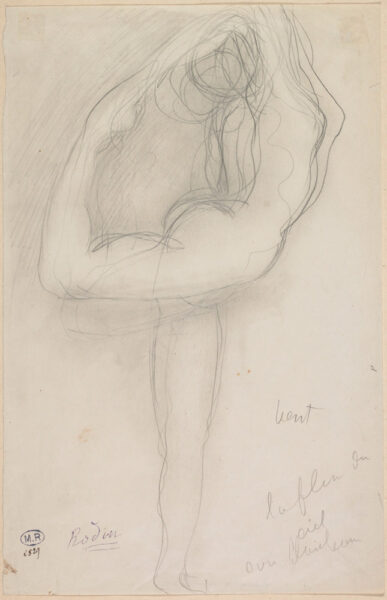
Auguste Rodin “Standing Nude Holding her Right Leg”, c.1903, pencil with stump on paper
Not every artist has the chance to draw from a posed dancer model. If you’re lucky enough to get this opportunity, then discuss in advance how they could best help you. Be reasonable and understanding. Don’t pressurise a dancer to hold a long uncomfortable static pose, e.g. with arms raised or balanced on one leg. This can lead to injury – the last thing that a dancer needs. Give your dancer model plenty of opportunities to pause during the session in order to drink water, to move about or to stretch. One tried and tested approach is as follows:
Ask your dancer to come in costume. They could bring along a prepared section of dance and a recording of its backing music. Offer the chance for the dancer to “warm up” on arrival before you start.
Have the dancer demonstrate a 1-3 minute section of their dance along with its backing music. Observe, or make a fleeting sketch if you wish.
Continue with three 5-7 minute poses in fairly relaxed positions. Standing poses can work well, or the dancer could find a relaxed position on the floor, for example pretending to adjust a shoe.
Then ask your dancer to hold a series of very short poses lasting from between 30 seconds to 3 minutes. Put them in control – As they go into the pose, they’re to tell you how long they’ll be holding it for. This is tiring: Offer plenty of breaks.
You could also ask the dancer to pick out one very short sequence from their dance (nothing too physically extreme) and to perform this repeatedly over a period of around 1-4 minutes. From this, you could draw either a very fleeting sketch, or a semi-abstract looping form that just suggests the nature of the movement.
Complete the session as suits you both. You could request a longer (e.g. 30-45 minute) static pose in costume, with the dancer reclining comfortably against cushions or resting in a chair. Or your dancer may wish to perform their prepared piece again for you, along with backing music. Make fleeting sketches from this, and/or take photos or video footage from various angles for your future reference.
Above: M.Dorn, Three fleeting sketches of the Indian Dancer Fabrizia Verrecchia, pastel on paper
In 2014, David Hockney invited dancers to pose in his studio for a series of paintings, some taking their inspiration from Henri Matisse. This followed on from a period of using multiple viewpoint photography to overcome the “problem” of perspective. He wrote,
“The very first picture of the dancers was of them stood in a circle; it was ok, but they weren’t moving, they weren’t dancing. I got them to go around in a circle, then I would say stop, and draw one and I slowly built it up.”
David Hockney
Posing a group of models enabled Hockney to make anatomical sense of the figures, both as individuals, and as a group holding hands. Unlike a rapid sketch, this thoughtful and controlled approach has helped Hockney to create pleasing finished compositions. Each works on an abstract level, from the shapes between limbs, to the dynamic tension between forms, and the distribution of colours within each painting.
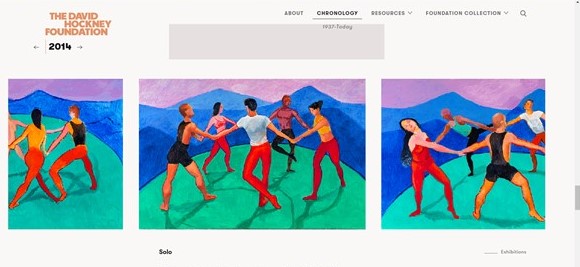
Drawing the dancer from photos
The camera can be an outstanding reference tool for the working artist. It captures vast amounts of information in an instant: For example limb angles, anatomy, patterns of light and shade, and the fall of folds of clothing. However, bear in mind these words of wisdom regarding the photographic representation of movement:
“Movement seized while it is going on is meaningful to us only if we do not isolate the present sensation either from that which precedes it or that which follows it”
Henri Matisse
This does not mean that working from photos must be completely avoided. Rather, photos can be used as an additional back-up reference tool if needed. They must be understood in context. What was happening just before and just after the photo was taken? How was the dancer moving?
To answer the above questions, it can be more useful to work from video footage (which you can then freeze-frame at a moment of your choice or replay on a loop).
Even when working from photos, try to get a sense of the “atmosphere” of the dance. Did the dancer(s) give an impression of easy elegance or exuberance, or tension? Was there a jostling crowd, a rapt audience, or an echoey empty room? It is best to be there at the live performance in order to absorb the experience before returning to the studio with your reference photos or video footage.
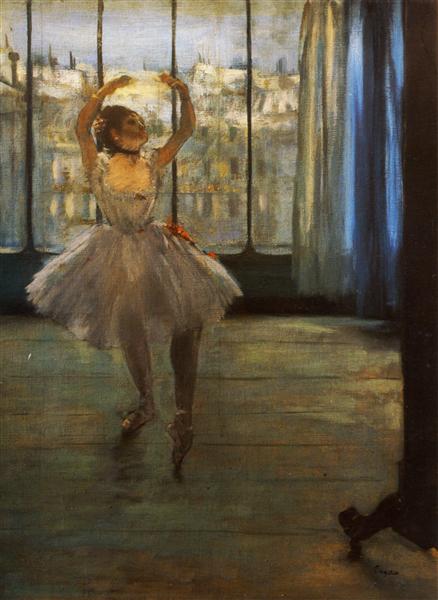
Above: Edgar Degas “Danseuse posant chez un photographe”, 1878, oil on canvas
Drawing the dancer from memory
Creating a picture of a dancer requires some memory drawing. This is the case even when working from the live model. Dancers move faster than any artist can draw or paint. Sketching the moving dancer therefore becomes an act of recording, not what the artist is currently observing, but what the artist remembers from some moments ago.
Perhaps you are working back in the studio after viewing a dance performance. In that case, memory plays a central role. Even with good photographic references to hand, the artist needs to think back to how the dancer was moving, the sense of tension in the dancer’s limbs, and so on.
And of course the artist needs to remember their own emotion on viewing the dancer in the first place. In 1976, Pierre Schneider gave a lecture at the Museum of Modern Art, New York, in which he quoted Matisse as saying,
“My painting is finished when I rejoin the first emotion that sparked it.”
Henri Matisse
In order to work in this way, take note of your first emotional response and then remember it throughout the creation of your piece of artwork.
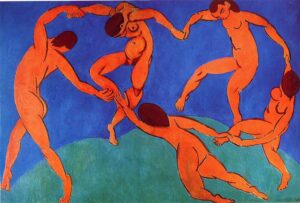
Above: Henri Matisse “Danse”, 1910, oil on canvas, 260x391cm
The artist does not only refer to a posed model or to photos. Whether fully aware of it or not, she also has some internal “reference” – an internalised feeling or response to having watched the dancer.
This internal reference may just be a vague emotional response such as a sense of lilting grace. Or it may be a visualised idea of a highly developed composition ready to be produced on canvas. Or perhaps it is somewhere between these two extremes, akin to a remembered fragment of a dream.
Take note of that dreamlike “internal reference”. This can be the spark that takes an image beyond mere technical drawing and turns it into a work of art.
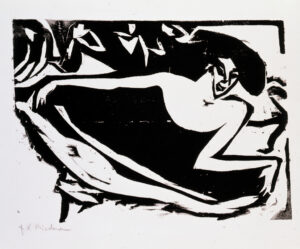
Above: Ernst Ludwig Kirchner, Dancer with Raised Skirt, 1909 woodcut
References
Corbett, R. (2016). You must change your life: The story of Rainer Maria Rilke and Auguste Rodin. WW Norton & Company.
Elderfield, J. (1984) The Drawings of Henri Matisse. Thames and Hudson.
| Tags: dance, life drawing, movement | More: Blog
| Tags: conveying emotion, exercises, warm-ups | More: Blog
Life drawings
December 16, 2018
- Blue female nude in ink
- Female figure turning
- Female nude sitting ink
- Female nude sitting turning pastel ink
- Flying men
- Male nude turning
- Nude leaning ink and pastel
- Nude sitting pastel ink
- Sitting female nude charcoal
- Sitting turning in ink
- Two nudes chalk charcoal
- Two nudes in ink and graphite
| Tags: charcoal, drawings, figures, ink, life drawing, pastel | More: Life drawing
Sketches: Musicians
- London Klezmer Quartet, M.Dorn, 2017, pen and acrylic in sketchbook
- London Klezmer Quartet, M.Dorn, 2017, collage, pen and acrylic in sketchbook
- London Klezmer Quartet, M.Dorn, 2017, collage, pen and acrylic in sketchbook
- Marco Marconi and Tina May, M.Dorn 2017
- Marco Marconi, M.Dorn, 2017
- Musicians at The Bear Club, M.Dorn, 2017
- Musicians at The Bear Club, M.Dorn, 2017
- Tsvey Kipperim 1, M.Dorn, 2018
- Tsvey Kipperim 2, M.Dorn, 2018
- Watching Tsvey Kipperim 1, M.Dorn, 2018
- Musician, M.Dorn 2018
- Watching Tsvey Kipperim 2, M.Dorn, 2018
- Tsvey Kipperim 3, M.Dorn, 2018
| Tags: drawings, sketches | More: Drawings, Sketches
Sketches
- Diners, M.Dorn, 2017, pen on torn newspaper
- M.Dorn 2017
- Seated woman, M.Dorn 2017, pen on torn magazine paper
- Evening sketch, M.Dorn, 2017
- Pollarded trees, M.Dorn, 2017, pens on torn newspaper
- Henry Moore sculpture and jellyfish, M.Dorn 2017, pen on magazine page collage
- St Leonards community garden, Hertford, M.Dorn 2017, oil pastel
- St Leonards church, Hertford, M.Dorn 2017, oil pastel
- “Stop”, M.Dorn, 2017, pen on torn newspaper
- Cafe pillars, M.Dorn, 2017
- Bowl of fruit, M.Dorn 2017, collage and paint in sketchbook
- M.Dorn, 2017
| Tags: drawings, sketches | More: Drawings, Sketches
Just Draw! Part 3: Outdoors
April 30, 2015

Above: One of my sketches in an A5 sketchbook using inks, pencils, watercolours and pens, 2010
Countryside and urban landscape are full of inspiration for the artist. Here in the UK, days are lengthening and weather is (sometimes) dry, so this is a great time to consider heading outdoors to draw.
A few practicalities
To get started, you really only need a sketchbook (or other drawing paper) and a pen or pencil. However, I suggest packing a few other bits and pieces to keep you comfortable during your drawing session:
- A lightweight folding stool or chair so that you won’t be restricted to drawing from park benches, etc. if you prefer to draw while seated.
- Layered clothing appropriate to the weather
- Snacks and hot or cold drinks to keep you going
- Rucksack to carry your stuff- you may choose to walk quite a distance between stopping to draw.
- If you wish, a few printed images of inspiring drawings (or download them onto a mobile)
- Tissues and/or wipes for clean-up
- A portable easel is optional, but is particularly useful if drawing on a larger scale.
You may also like to bring a variety of art materials. Here are some suggestions:
- Either a sketchbook or a drawing board plus bulldog clips and loose sheets of various papers
- A few ballpoint, marker and/or nibbed pens
- A few sticks of charcoal and chalk and a putty rubber (this works well with toned paper). Charcoal smudges, so bring greaseproof/parchment paper with which to protect your work on the way home if required. Also do remember wipes for clean-up.
- A little watercolour pan set plus either a water-brush or a normal brush plus screw-top container of water
- A pot of ink (brown is lovely) plus water for clean-up, and a dip pen plus one or more nibs. For ink and wash techniques, also bring a brush and one or more little containers in which you can dilute the ink.
- A graphite stick
- Pencils (coloured or otherwise) plus a good sharpener and a bag or container for any pencil-sharpenings.
Possibilities for outdoor drawing are limitless. Here are a few ideas to get you started:
A broad landscape showing the lie of the land
Above: Vincent van Gogh drawing in pencil, reed pen and brown ink, c1888
Medium: Pen and ink on cartridge-type paper. A ballpoint, cartridge or marker pen are fine. For more characterful lines, try a nibbed dip pen or reed pen plus a bottle of ink. You’ll also need an HB or 2B pencil for a little light under-drawing.
Subject: Any landscape or cityscape in which your view is not obstructed by nearby trees or buildings.
Looking at the subject: Can you see the foreground, middle distance and far distance? Remember that, whether you choose to sit or stand while drawing, the horizon-line will be at you eye level. Can you see any part of the horizon, or do buildings or trees entirely obscure it? Is the ground flat, or does it slope one way or the other? Decide how much of the view you’d like to include in your drawing.
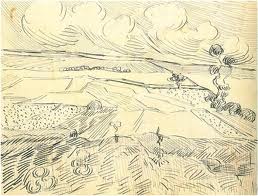 Above: Three drawings by Vincent van Gogh (1853-1890)
Above: Three drawings by Vincent van Gogh (1853-1890)
The drawing: In this drawing, you’ll aim to convey a general sense of the “lie of the land” (US: “lay of the land”), i.e. its hilliness or flatness, and a sense of distance. Textures of surfaces can also be suggested.
Start with a few light pencil marks on your page to show where the important bits of the landscape are to be positioned in your drawing. These pencil marks can be erased or forgotten once you have drawn in pen over the top of them. I suggest marking a faint horizontal line across the page to show the level of the horizon. Also use your pencil to indicate where any buildings, hedges, paths are to go. Try to indicate with your pencil the position of slopes in the ground, if any are present.
Now tackle the drawing with pen. I suggest an approach similar to that used by Vincent van Gogh in many of his drawings. Work across the landscape, using whichever pen marks you choose (dots, sweeping strokes, etc.) to suggest the slope or direction of the land and the texture of the surface. Keep your pen marks lively. We are not trying to convey the effects of light here, so laborious cross-hatching or shading are not required.
Pen marks should tend to get smaller as they disappear into the distance in your picture. They may also converge into the distance, e.g. if suggesting rows of corn or edges of a path leading into the picture. This helps to give your picture a sense of distance.
Taking this idea further: You may wish to develop this idea by drawing in colour. Feel free to use the same linear style as described above, this time working in coloured inks, coloured pens or pencils. If you wish, you may choose colours to help emphasise a sense of distance (cool colours tend to recede, while warm ones come forward). Your colours may be based on those of the landscape itself, or you may opt for a more experimental approach, with colour providing a sense of emotion.
Above: David Hockney, pages from a Yorkshire Sketchbook, c.2004
Like David Hockney (see image above), you could add in blocks of painted colour if you wish. Several of Hockney’s landscape sketches have a similar “lie of the land” approach to those of van Gogh, with an emphasis on distance and topographical features of the landscape, plus touches of surface texture.
A tonal approach to trees
Above: Claude Lorrain “A group of trees on a riverbank” c1640-45, brown ink with underlying black chalk
When the evening light is fading, have a go at drawing the silhouetted shapes formed by trees. These could be very quick, fleeting sketches suggesting the general shape of the tree masses. Charcoal, graphite or brush with ink are all ideal for sketching simple trees, or you could block them in using pen or soft pencil. Try doing several little sketches of different trees (or groups of trees) across a double-page spread of your sketchbook before the sun completely disappears.
Trees do of course form tonal shapes at any time of the day. Look at them with screwed-up eyes to emphasise this effect.
For a more finished drawing, as in Lorrain’s image of trees, above, look out for any more subtle variations in tone. As a whole, the trees and the ground that they stand on may be much darker than the sky behind. However, a closer look reveals some parts to be a deep, almost black shadow, while other parts are lighter in tone.
Above: Odilon Redon “Deux Arbres” 1875
Tone can have quite an emotional impact (for example, see the image by Redon, above). When you are exploring woodland, other countryside or urban areas, keep an eye out for those unexpected dark shadows or startling contrasts that make you look twice.
Trees with character
Each tree has its own unique structure depending not only on its species but also on its history, the prevailing wind and so on. They are just as worthwhile to draw as a human or animal figure though, of course, they will neither walk away nor charge you by the hour.
Drawing trees can be approached in a similar manner to life drawing. Just as when drawing the human figure, it helps to check proportions with care:
- Check, for example, whether it is taller than it is wide.
- At which point off the trunk do the lowest branches emerge – a half, a third or a quarter of the way up?
- Do the branches reach up almost vertically to the sky, do they stretch out horizontally, or do they branch off from the trunk at an angle?
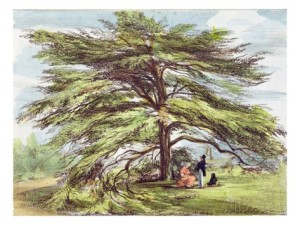
Above: George Ernest Papendiek (1788-1835) “The Lebanon Cedar Tree in the Arboretum at Kew Gardens”
The general structure of the tree should be drawn out before considering adding small details. If attempting to draw the entire tree, do step back far enough so that you can see the entire structure without moving your head, even if this means working from the opposite end of the field.
A few ideas for drawing individual trees:
1) In graphite, pencil or pen. Using the whole double-page spread of your sketchbook, sketch the tree very rapidly using a continuous-line technique, i.e. do not lift your drawing tool off the paper form start to finish. You should end up with a flowing image with an intuitive quality.
2) In pencil, charcoal or graphite, use a more careful, structural approach to drawing a tree. Work much more slowly (e.g. over a period of 40-60 minutes). Make multiple measurements using your outstretched arm to check the proportions of trunk, main branches and masses of foliage, and estimate angles of the main branches. Use the tip of your charcoal or graphite stick to draw edges in once you have worked out where they should go. As you build this drawing up, turn the charcoal or graphite on its side to block in regions of dark tone if you wish.
3) In any medium of your choice, draw from the tree using a mixture of careful measuring marks and more intuitive, flowing lines. A tree that is growing at an unusual angle is a good one to draw to start with. Leave about 30 minutes for this drawing as it is better left uncompleted than overworked. I suggest starting by making a few measurements and checking how your tree will fit onto your paper. Work into the drawing more boldly to emphasise the direction of the trunk and branches and perhaps to suggest movement if it is a windy day.
Above: Eugene Delacroix “Study of an Oak”, graphite on wove paper, 21 x 33.8cm, 1857
| More: Blog
Just Draw! Part 2: indoors
February 19, 2015
Following on from my recent discussion on returning to drawing, this article presents a variety of suggestions for drawing indoors.
Feel free to pick and choose from this selection of drawing ideas and to approach them in any order. These “exercises” are primarily designed to get people drawing again, but they also encourage us to look at the world afresh and to think.
1) Create a pleasing line drawing from the objects in front of you, Matisse-style
Above: Henri Matisse, “Still Life, Fruit and Pot”, 1940
Medium: Pen on cartridge paper.
Subject: A group of objects, as you find them, in your home or studio. Rounded items, such as pots and fruit, are pleasant to include but not essential. Paint tubes and brushes as you find them on a table, items on a kitchen counter-top or shoes on a rack are a few other suggestions.
Also include the space around the object, which may include the wall behind, a section of floor and perhaps even your own hand (see Matisse’s drawing, above). You can (optionally) move the items around just a little before you start to draw, but do not spend ages setting up a traditional still-life arrangement.
Looking at the subject: Even if the objects do not immediately strike you as beautiful, perhaps their shapes have some pleasing properties. Look both at the objects themselves, and at the negative shapes between them. Are there adjacent areas of pattern (e.g. tiles, wood-grain, wallpaper) that you might like to include? A strong diagonal shape within the image can be helpful but not essential (e.g .the table edge in Matisse’s still life, above, and in Bob Dylan’s image, below). The spaces between the objects and the edge of your drawing are going to be key, so think in advance about how you’ll fit what you see onto your page. You may like to use a cardboard viewfinder to help find the most pleasing composition.
The drawing: You’ll be aiming at a rather decorative line drawing with an emphasis on shape and pattern. Do not worry about the technical “correctness” of your finished drawing. Accurate perspective and measuring are not important here.
If you have used a viewfinder to help plan the composition, then start by checking that your drawing will be in proportion to that viewfinder. You could either use an entire sheet of paper for your drawing, or draw out a rectangle to represent the edges of your image, and then work within that.
Feel free, if you wish, to make a few initial marks in pencil so that you know where your objects will sit within the picture, or perhaps to start with a faint pencil gesture drawing. Then proceed in pen. Keep your pen marks lively and confident. Ignore tone- just represent edges of objects and any patterns that you see. Make sure that your pen lines are not all clustered in one part of the drawing. If necessary omit details and patterns in certain areas of the image and emphasise them in others. A pleasing image will have a balance of lines and quiet spaces.
Optional: Taking this idea further
Above: Bob Dylan, “Still life with peaches”, 2007, mixed media on paper, 76x61cm
If you are yearning for colour, then consider adding some in to your drawing in a rather abstract way. Such a flat style of line drawing provides a good “excuse” for not aiming at photographic realism when adding colour.
Once you are happy with the balanced composition of your pen drawing then you have some options. You may choose to add colour directly to your drawing using marker pens, gouache, crayons, etc.
Alternatively, you could scan and print your uncoloured pen drawing onto artists’ paper, perhaps with some enlargement (a basic computer and printer set-up can be used). Colour is then added to the printed copies using any medium of your choice. If you print multiple copies, then you can try out all kinds of colour combinations and techniques while still retaining your original pen drawing.
For example, Bob Dylan included six differently-coloured versions of his “Still life with peaches” in his “Drawn Blank” series, my favourite of which is shown above. Others were coloured in earthy or warm brown-orange tones. The use of colour changes the emphasis within the composition, and also gives each image its own emotional “punch”.
2) An intuitive approach to structural drawing
Above: Alberto Giacometti, “Man Walking”
Medium: Pencil on cartridge-type paper
Subject: Any room with some freestanding furniture on the floor. One or more chairs, and perhaps a standard lamp, an easel and/or general household mess are all great to include (don’t tidy up first!).
Looking at the subject: Find yourself somewhere to sit or stand (you’ll need to settle in one place for the duration of this drawing) and take at least two minutes to look at the room in front of you.
- Which objects are nearest to you?
- Notice that the edges of some objects may seem to overlap the edges of others (simply because some objects are in front of others).
- Notice that some objects appear to be lower down than others because they are nearer or further away from your eyes.
- If the room is not cluttered, look out for sizeable areas of floor or wall in between the objects that act like blank “negative spaces”.
- Try moving your head a little….Does this affect the spaces between the objects?
The drawing: In this exercise, you’ll aim to create a simple line drawing of the room, a bit like Giacometti’s studio drawings (one of which is shown above). The focus here is on spatial relationships, i.e. how the objects are positioned relative to one another. The search for structure is key, so guidelines and overlaid corrected lines can form part of the finished drawing.
Start drawing edges of the main objects using a gentle, “searching” type of pencil mark. Keep looking back at the subject for more clues. In your drawing, mark in where any two objects overlap one another. Feel free to draw faint guidelines between the objects to help align them on the page as follows:
- Do any objects appear to your eyes to be lined up exactly, either one above the other, or lined up horizontally? If so, you may like to draw vertical or horizontal lines to help you position them appropriately within your drawing.
- Look out, as well, for diagonal relationships between objects. E.g. you may imagine a diagonal line running from the corner of a table to the top corner of a cupboard. You could draw this imagined diagonal line into your picture as a structural guide, to help establish the position of cupboard and table (click here for tips on estimating the slope of a diagonal line). If, in real life, the cupboard is behind the table, then you can imagine your diagonal line moving deeper into the picture plane as you draw it travelling from table to cupboard. Feel free to add in as many imagined diagonal lines between objects as you wish…perhaps ending up with a web of light lines suggesting space between near and far objects.
Another way to approach this kind of drawing: Once you get the hang of the structural drawing approach, start to focus more on the negative shapes between the objects. What kinds of negative shapes do you see? Is there a pleasing balance of lines and negative shapes in your picture, as in Giacometti’s studio drawings, or is your entire image too “busy”? You may like to try out more drawings of the same room, perhaps from different viewpoints, with this in mind.
3) Draw your own unmade bed
Above: Eugene Delacroix “An unmade bed”, watercolour over graphite, 20.6×24.1cm
Medium: Whatever is to hand (pen or pencil, crayons or watercolour, etc.)
Subject: Your unmade bed, just as you find it. This is a great subject for the following reasons:
- Your own bed is personal to you, the artist.
- It will look different every morning depending on which position the bedding has happened to take.
- Those random twists and folds in pillows, sheets and quilt are interesting and deserve a second look.
- Bedroom lighting (from a lamp, or through half-opened curtains) emphasises interesting masses of tone or pools of light on your bedding.
- This is a good excuse not to make your bed.
Drawing approach: In order to keep this drawing fresh and immediate, I strongly recommend setting yourself a time limit. This could be 10-30 minutes depending on your chosen medium. If there is something that you really want to include (e.g. a directional twist to the sheets, or a dramatic pool of shadow) then be sure to get this in within your time limit.
Include as much or as little of the bed as you wish (if observing it from within a small room, then it may be best to include just one section, as you will not be able to step back far enough to see the whole bed without moving your head).
Other personal subjects in the home or studio: If ever stuck for ideas for what to draw, remember that you need not leave your front door in order to find inspiration. Some of the best subjects are those that are most personal to us. These are often overlooked. Here are a few more examples:
- Your shoes, just as you find them on the floor (perhaps refer to Van Gogh’s shoe paintings).
- Your cup or glass once you’ve finished drinking from it. Notice where it is positioned, as this says something about the hand that has just left it. Do include the edges of any adjacent objects in your sketch.
- Your coat or other clothing on a chair. This could be an energetic image like Cezanne’s watercolour, below. Alternatively, you could think more of the weight of the fabric hanging from the chair.
Above: Paul Cezanne “Coat on a chair”, 48x31cm, watercolour, 1892
Draw a room, this time giving light more importance than objects.
Above: Vincent Van Gogh “Interior with woman sewing”, c.1885
Medium: Pen on cartridge-type paper.
The subject: Any medium to large room of your house, or your studio. If drawing during daylight hours then make use of light through the window. If it is dark outside, then light from a directional lamp (e.g. a domestic table or floor lamp) will work better than that from a central ceiling light.
Looking at the subject: Do take at least a couple of minutes to look and think before you start to draw. In this drawing, you’ll be focusing both on the spaces between the objects in the room, and the effect of the light, so there is plenty to think about. Notice the following:
- Where is your own eye level? That is, how high up are your eyes in relation to the rest of the room. I suggest starting by drawing a faint horizontal pencil line across your drawing paper to represent your eye level. Any object which is above your eyes in real life will then be drawn above that line, whereas any object that is below your eyes will be drawn below it.
- Where is the light coming from? Note the position of any sources of light such as window(s), open doorway, lamp(s). Out of all of these, there may perhaps be one main light source. E.g. in Van Gogh’s “Interior with woman sewing”, the light is coming from the upper right side of the picture, with shadows falling to the left of the objects. There is light coming from the window next to the sewing woman, but the fall of the shadows suggests that there is another bright window or open doorway in the far right, not included in the picture.
- Where are the main pools of light and shadow in the room? Screw up your eyes to simplify the tones that you see.
- How much of the room do you want to include in your picture? Use a cardboard viewfinder (or frame the view with your fingers) to help choose a rectangular image from what you can see in front of you. Include some pleasing patches of both light and shade within your chosen composition.
The drawing: Start by laying the picture out with a few faint pencil lines before embarking on the pen drawing. Your pencil marks are just rough guides as to where key parts of the picture will go. Do not make a complete pencil drawing and then slavishly work over it in pen!
Look at the room with screwed-up eyes to check tonal values then, starting in a dark area of the room, start to use pen lines to build up the picture. Vertical and/or horizontal pen lines (as in the Van Gogh picture above) are useful for suggesting tone in the room that is not associated with any particular object. Use thicker or overlaid lines to create darker areas of tone. Leave the paper untouched to suggest pools of light.
Use your pen to add in furniture and a few architectural details but, when doing this, don’t add more pen lines than needed. Give the light and shade in the room more emphasis than the objects themselves. Some of the furniture’s edges may even seem to “disappear” within a pool of hatched shadow.
A view through a window, Matisse-style
Above: Henri Matisse, “Open window at Etratat”, 1920
Medium: Pen on cartridge-type paper.
The subject: An open or closed window in your house or studio, whatever you can see through that window, plus a view of some of the room’s interior This may just be objects on the window-sill or, as in Matisse’s drawing shown above, you could include space above, below and in front of the window.
Looking at the subject: When looking from the inside of a room at a window, we naturally focus either on the view through it, or on the window-frame plus surrounding walls, etc. For this exercise, the challenge is to look at the interior of the room, the window-frame and the view through the window all at once.
Do the objects outside the window have any relationship to what is inside? Whether you are looking out onto a street, a brick wall or a landscape, see if you can relate outdoor shapes and patterns to those seen indoors.
The drawing: As in the other Matisse-inspired drawing (no 1, above), again use pen lines to create patterns and object edges. Shapes, patterns, and their relationship to one another and to the edges of the drawing, are key to this style of work.
In making this drawing, see if you can make sense of your window image without adding any tonal shading whatsoever. If you do decide to add a little tone (and you may well do if there is bright light streaming through the window) then use it sparingly as Matisse did in “Open Window at Etratat”. Instead of resorting to shading techniques, try adjusting your line thickness or changing the density of your patterned marks to suggest tone.
| Tags: Bob Dylan, Giacometti, Matisse, Van Gogh | More: Blog
Just draw! Part 1: Getting back into drawing.
February 11, 2015
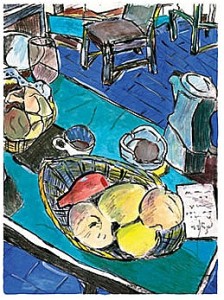 Above: Bob Dylan, “Still life with peaches”, mixed media on paper, 2007
Above: Bob Dylan, “Still life with peaches”, mixed media on paper, 2007
Getting back into drawing
At the best of times, drawing and creativity can seem wonderfully addictive. But there are inevitable periods in every artist’s life when the artwork just seems to stop happening for a while. Perhaps other aspects of life have become more demanding or compelling. This needn’t be a problem unless:
1) Having broken the “habit” of drawing, you start to lose confidence in your ability or in your materials.
or
2) You not only stop drawing, but you stop “looking”, i.e. observing and thinking.
In such cases, the thought of starting to draw again may seem pointless or perhaps even fill the artist with dread. As the ability to create art is tightly-bound to an artist’s sense of self, there tends to be a basic emotional need to continue. Worries about getting back into drawing (or other art-making) typically leave the artist feeling conflicted.
So…how can one best “get back into drawing”?
In this and the next few articles, I’ll offer some practical suggestions for returning to art-making and some relevant drawing exercises. This is a universal issue for artists, so do feel welcome to post comments at the end of the article if you have further suggestions to offer.
A few practical tips on rekindling your old art addiction
If you’ve got “out of the habit” of making art, then just getting down to it again can seem daunting. It is worth pushing yourself through this stage:
- Set aside a regular short time in which you’ll get on with drawing (or using any other chosen medium) in a business-like way. A session as short as 15 minutes per day will suffice if you are busy. A regular half-hour slot may feel more satisfying. Feel free to set a timer to separate your “drawing time” from the rest of the day.
- During your chosen “drawing time”, be very clear with yourself about avoiding distractions such as internet, mindless housework, phone, etc.
- Keep your chosen art materials ready for the next use. Pencil(s) should be left sharp, paper ready-clipped to a board or in a sketchbook. If using paints then aim to leave all equipment clean and ready for the next session. If you have space then do not replace paints and brushes in a drawer, but leave them ready to pick up and use again. If using an easel then leave it set up and ready to go.
Regain the knack of really “looking” at the world:
- It doesn’t matter how boring your surroundings initially appear to be. Click here for an article on looking and seeing. Play around with observing your surroundings in an abstract way, and combine this with taking a few photos if you wish.
- In the words of Bayles & Orland in their highly recommended book, “Art and Fear”, start to “notice the things you notice”. Pay attention to your personal reactions (both to objects and ideas) as these are key to the art that you will go on and make.
Above: Starting to look at the world in an abstract way.
Using drawing both to build confidence and to spark ideas:
Drawing on paper (as opposed to painting, printing, sculpture, etc.) is well-suited to the returning artist who requires a versatile, experimental approach. Pen, pencil or crayons are useful allies: portable, non-messy and adaptable, they are always ready to be picked up and used.
As ever, it is useful to turn to the great artists for inspiration. However, I never aim for a “perfect piece of work” comparable with a known masterpiece. Not only would such an approach inevitably lead to frustration but, in my opinion, a goal of complete perfection has little to do with the artistic thought process. On the other hand, borrowing certain ideas, practical methods and “ways of seeing” from other artists can be extremely useful in getting us back on track.
Above: A studio drawing by Alberto Giacometti. Without being in any way overwhelmed by Giacometti’s achievement, we can use this drawing to get us looking at scale, at spatial relationships between objects, and busy versus quiet areas within a composition.
During the past few years, I’ve written down outlines for numerous drawing suggestions for my own use, each inspired by a famous artist’s sketch or drawing. Each drawing idea includes a suggestion for subject, medium and approach. Over and again, these lists of ideas have proved invaluable in getting me drawing again when I feel “stuck”, and are always a good starting-point for completely new artistic approaches.
Poor weather or a lack of inspiring subject need not stop us from drawing. In my next article, I shall share a range of drawing suggestions that can be started and completed indoors, within any home or studio.
| Tags: artist's block, blog | More: Blog
Composition dogs: part 3
November 06, 2014
Dogs and owners: Spaces between
Above: “Eli and David”, by Lucian Freud, 2005-6. A portrait of David Dawson (Freud’s assistant and friend) with his whippet.
I find “Eli and David” remarkable both as a powerful composition and for the way in which it demonstrates a key aspect of human-canine relationships. This man, painted with all his human flaws and concerns, comes under our close scrutiny, but the dog accepts and trusts him regardless. As in several of Freud’s canvases, the dog does not care about the figure’s semi-nakedness or awkward pose. Squashed together within the armchair, dog and owner appear to accept one another’s close presence without criticism or complaint.
Compositionally, this painting has a wonderful abstract quality. It is broken into major sections by the horizontal edges of chair back and dog’s back, with the black background forming a strong inverted “L” shape. The side of the chair forms a vertical barrier against which the dog’s head is squashed, adding a feel of dynamic tension to the whole image. Negative shapes between dog, chair and man echo one another pleasingly.
Above: Mary Cassatt “Little girl in a blue armchair”, 1878, oil on canvas
Similarly, the girl sprawled in the chair in Cassatt’s image appears uninhibited in the presence of her canine companion. Both girl and dog are dwarfed in this room of outsize armchairs and this image could represent the strange childhood sensation of feeling out of place. Apparently unaware of the painter, the girl looks to the dog for companionship though, in this case, there is a quite a void of grey carpet between them. Painted as a rounded, enclosed, intensely dark oval, this terrier forms a strong enough shape to counterbalance the image.
Above: Piero di Cosimo “A Satyr mourning over a Nymph”, c1495, oil on poplar, 65.4 x 184.2cm
In contrast, the final image in this series is otherworldly. The fallen female figure is the nymph, Procris, who in Greek mythology was accidentally shot and killed by her husband, Cephalus. The presence of both satyr and dog is mysterious. A satyr was not present in the original story, and the identity of the dog is unclear.
Between them both, the satyr and foreground dog create a compositional arch above the dead nymph. Look at the curves of their backs clear against the sky. Though the husband (the only human in the story) seems to have disappeared, this arch suggests care, protection and fidelity. The satyr shows compassion and tenderness, but the dog gazes unflinchingly at the strange scene. As probably occurs over and again in real life, this dog has been a silent witness to some strange human drama.
